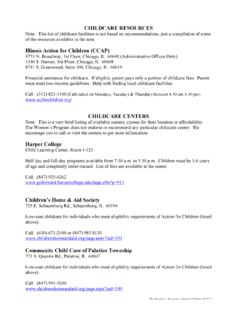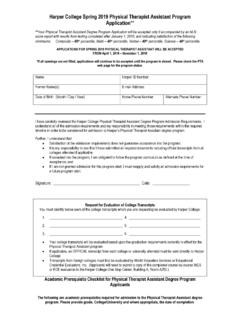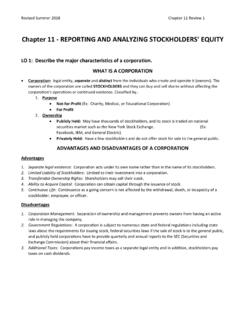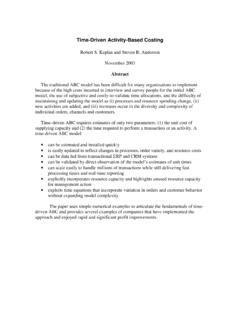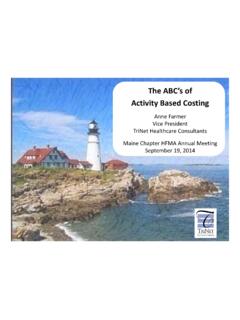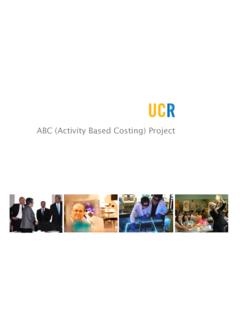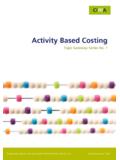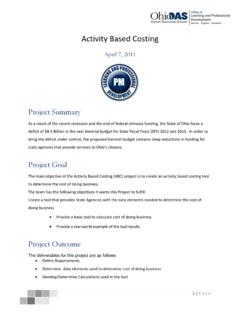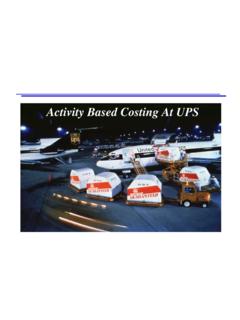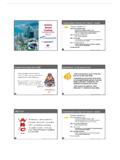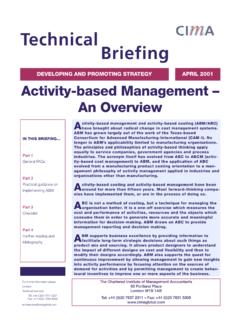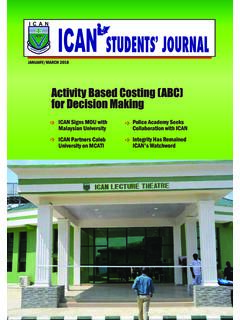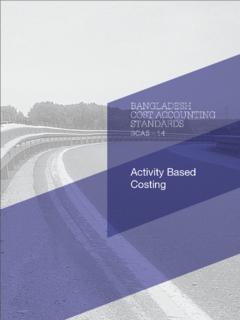Transcription of ACTIVITY BASED COSTING - harpercollege.edu
1 Revised Summer 2016 Exam Review Page 1 of 16 ACTIVITY BASED COSTING Key Topics to Know Job COSTING relied on a single plantwide overhead rate. Departments with very different processes may use departmental overhead rates instead of a single plantwide rate to improve accuracy. Differences between ACTIVITY - BASED COSTING and a traditional COSTING system (either single rate or multiple rates) Understand the ABC methodology: o How to compute ACTIVITY rates for cost pools. o How to assign costs to products. o How to compute overhead cost per unit for each product. o How to compute total unit cost for each product. o How to apply overhead to production in work-in-process. o Explain why product costs computed under ACTIVITY BASED COSTING and conventional COSTING methods differ. Flow of costs in an ACTIVITY BASED COSTING system. Revised Summer 2016 Exam Review Page 2 of 16 Problems Problem #1 P Company manufactures two products, Product C and Product D.
2 Estimated manufacturing overhead costs are $130,890 that will be applied to products on the basis of direct labor hours. Data concerning the current period s operations appear below: Product C Product D Estimated volume 400 units 1,200 units Direct labor hours per unit hour hours Direct material cost per unit $ $ Direct labor cost per unit $ $ Management is considering using ACTIVITY - BASED COSTING to apply manufacturing overhead cost to products. The ABC system would have the following cost pools: ACTIVITY Cost Pool ACTIVITY Measure Estimated Overhead Cost Machine setups Number of setups $ 13,570 Purchase Orders Number of purchase orders 91,520 General Factory Direct labor hours 25,800 ACTIVITY Measure Product C Product D Total Number of setups 100 130 230 Number of purchase orders 810 1,270 2,080 Number of direct labor hours 280 1,440 1,720 Required: a) Compute the predetermined overhead rate under the current method and determine the unit product cost of each product.
3 B) Determine the ACTIVITY rates ( predetermined overhead rates) c) Compute the total overhead cost applied to each product and determine the amount of overhead cost per unit of each product. d) Compute the unit product cost of each product. e) Compute the overhead applied to work-in-process using both traditional COSTING and ABC with the following actual ACTIVITY : ACTIVITY Measure Job Number of setups 10 Number of purchase orders 40 Number of direct labor hours 60 Revised Summer 2016 Exam Review Page 3 of 16 Problem #2 V Corporation's ACTIVITY - BASED COSTING system has two cost pools: Machining and Set Up. The company's overhead costs, which consist of equipment depreciation and indirect labor, are allocated to the cost pools in proportion to the ACTIVITY cost pools' consumption of resources. Equipment depreciation $32,000 Indirect labor 4,000 Distribution of Resource Consumption by Cost Pool Machining Set Up Total Equipment depreciation $12,800 $19,200 $32,000 Indirect labor 2,000 400 2,400 Total $14,800 $19,600 $34,400 Costs in the Machining cost pool are assigned to products BASED on machine-hours (MHs) and costs in the Set Up cost pool are assigned to products BASED on the number of batches.
4 MHs Batches Product R3 3,800 300 Product D6 16,200 700 Additional data concerning the company's products appears below: Product R3 Product D6 Sales $168,700 $185,600 Direct materials 77,800 72,300 Direct labor 75,800 79,300 Required: a) Calculate ACTIVITY rates for each ACTIVITY cost pool using ABC. b) Determine the amount of overhead cost that would be assigned to each product using ABC. c) Determine the operating income for each product using ABC. Revised Summer 2016 Exam Review Page 4 of 16 Problem #3 W Corporation has an ACTIVITY - BASED COSTING system with two ACTIVITY cost pools-Processing and Set Up that correspond to the two manufacturing departments. Costs in the Processing cost pool are assigned to products BASED on machine-hours (MHs) and costs in the Setting Up cost pool are assigned to products BASED on the number of batches. 90% of the machine hours are worked in the Processing Department and 10% are worked in the Set Up Department.
5 Data concerning the two products and the company's costs and ACTIVITY - BASED COSTING system appear below: Processing $12,200 Setting Up 25,100 Machine Hours Processing Set Up Total Batches Product C7 2,160 240 2,400 700 Product P8 15,840 1,760 17,600 300 Total 18,000 2,000 20,000 1,000 Product C7 Product P8 Sales $135,700 $98,000 Direct materials 61,700 31,000 Direct labor 52,200 45,800 Required: a) Calculate ACTIVITY rates for each ACTIVITY cost pool using ACTIVITY - BASED COSTING . b) Determine the amount of overhead cost that would be assigned to each product using ACTIVITY - BASED COSTING . c) Determine the single plant-wide overhead rate BASED on machine hours. d) Determine the amount of overhead cost that would be assigned to each product using the single plant-wide overhead rate. e) Determine the overhead rates for each manufacturing department BASED on machine hours. f) Determine the amount of overhead cost that would be assigned to each product using the multiple department overhead rates.
6 Revised Summer 2016 Exam Review Page 5 of 16 Problem #4 M Company allocates overhead in the Machining Department on the basis of machine hours, while in the Assembly Department overhead is allocated on the basis of direct labor cost. The following budget data are provided: Machining Assembly Manufacturing overhead $500,000 $1,075,000 Direct labor 350,000 500,000 Machine hours 100,000 10,000 Direct labor hours 50,000 150,000 The following information is provided for a job (Job No. 510) recently completed by the company: Machining Assembly Direct materials $25,000 $37,500 Direct labor 10,000 12,500 Machine hours 5,000 1,000 Direct labor hours 2,000 3,000 Required: a) Compute the two departmental overhead rates. b) Compute the cost of Job No. 510. c) Assume that the company decides to use a single overhead rate for the two departments, calculated by adding their overhead costs and using direct labor hours as the allocation base.
7 What would the overhead rate be, and how much manufacturing overhead cost would be assigned to Job No. 510? Revised Summer 2016 Exam Review Page 6 of 16 Multiple Choice Questions The next 4 questions refer to the following information. N Company produces two different products using two different activities: Machining, which uses machine hours as an ACTIVITY driver, and Inspection, which uses number of batches as an ACTIVITY driver. The cost of Machining is $500,000, while the cost of Inspection is $30,000. Usage of the ACTIVITY drivers are as follows: Product A Product B Total Machine hours 1,000 3,000 4,000 Number of batches 45 15 60 Product A is assigned $125,000 in Machining cost, and $22,500 in Inspection cost. Product B uses 75% of total machine hours and 25% of total batches. 1. What is the ACTIVITY rate for Inspection? a) $125 per batch b) $500 per batch c) $667 per batch d) $2,000 per batch 2.
8 What is the total Inspection cost assigned to Product A? a) $7,500 b) $22,500 c) $125,000 d) $375,000 3. What is the total ACTIVITY cost assigned to Product B? a) $7,500 b) $147,500 c) $375,000 d) $382,500 4. What proportion of Machining ACTIVITY is used by Product A? a) 25% b) 33% c) 67% d) 75% Revised Summer 2016 Exam Review Page 7 of 16 5. Which of the following is most likely to be true of the manufacturing overhead costs assigned to a product with relatively low volume and high complexity? a) An ABC system will assign more manufacturing overhead costs to the product than a volume- BASED system. b) A volume- BASED system will assign more manufacturing overhead costs to the product than an ABC system. c) An ABC system will assign the same manufacturing overhead costs to the product as a volume- BASED system. d) An ABC system will assign manufacturing overhead costs to the product, while a volume- BASED system will not.
9 6. B Company manufactures a product that uses $15 in direct materials and $5 in direct labor per unit. Under the traditional COSTING system Buhl uses, manufacturing overhead applied to each unit is $12. Buhl is considering switching to an ABC system, under which the total overhead cost would be $25 per unit. What is the total manufacturing cost per unit for Buhl under the ABC system? a) $20 b) $25 c) $32 d) $45 7. L Company has provided the following data from its ACTIVITY - BASED COSTING accounting system: Pools Total Cost Total ACTIVITY Designing products $1,372,448 7,798 product design hours Setting up batches $33,300 740 batch set-ups Assembling products $126,160 6,640 assembly hours The ACTIVITY rate for the Designing Products ACTIVITY cost pool is closest to: a) $101 per hour b) $1,372,448 per hour c) $176 per hour d) $57 per hour Revised Summer 2016 Exam Review Page 8 of 16 8. In ACTIVITY - BASED COSTING , the ACTIVITY rate for an ACTIVITY cost pool is computed by dividing the total overhead cost in the ACTIVITY cost pool by: a) the direct labor-hours required by the product.
10 B) the machine-hours required by the product. c) the total ACTIVITY for the ACTIVITY cost pool. d) the total direct labor-hours for the ACTIVITY cost pool. 9. N Company manufactures and sells two products: Product U5 and Product X2. The company has an ACTIVITY - BASED COSTING system with the following ACTIVITY cost pools, ACTIVITY measures, and expected ACTIVITY : Expected ACTIVITY ACTIVITY Cost Pools ACTIVITY Measures Estimated Overhead Cost Product U5 Product X2 Total Labor-related DLHs $36,180 2,400 1,200 3,600 Product testing tests 65,760 400 600 1,000 General factory MHs 133,984 4,000 3,900 7,900 $235,924 The total overhead applied to Product U5 under ACTIVITY - BASED COSTING is closest to: a) $141,555 b) $67,839 c) $157,272 d) $118,264 Revised Summer 2016 Exam Review Page 9 of 16 10. M Company manufactures and sells two products: Product K2 and Product O8. Data concerning the expected production of each product and the expected total direct labor-hours (DLHs) required to produce that output appear below: Expected Production Direct Labor-Hours Per Unit Total Direct Labor-Hours Product K2 500 4,500 Product O8 700 8,400 Total direct labor-hours 12,900 The direct labor rate is $ per DLH.




